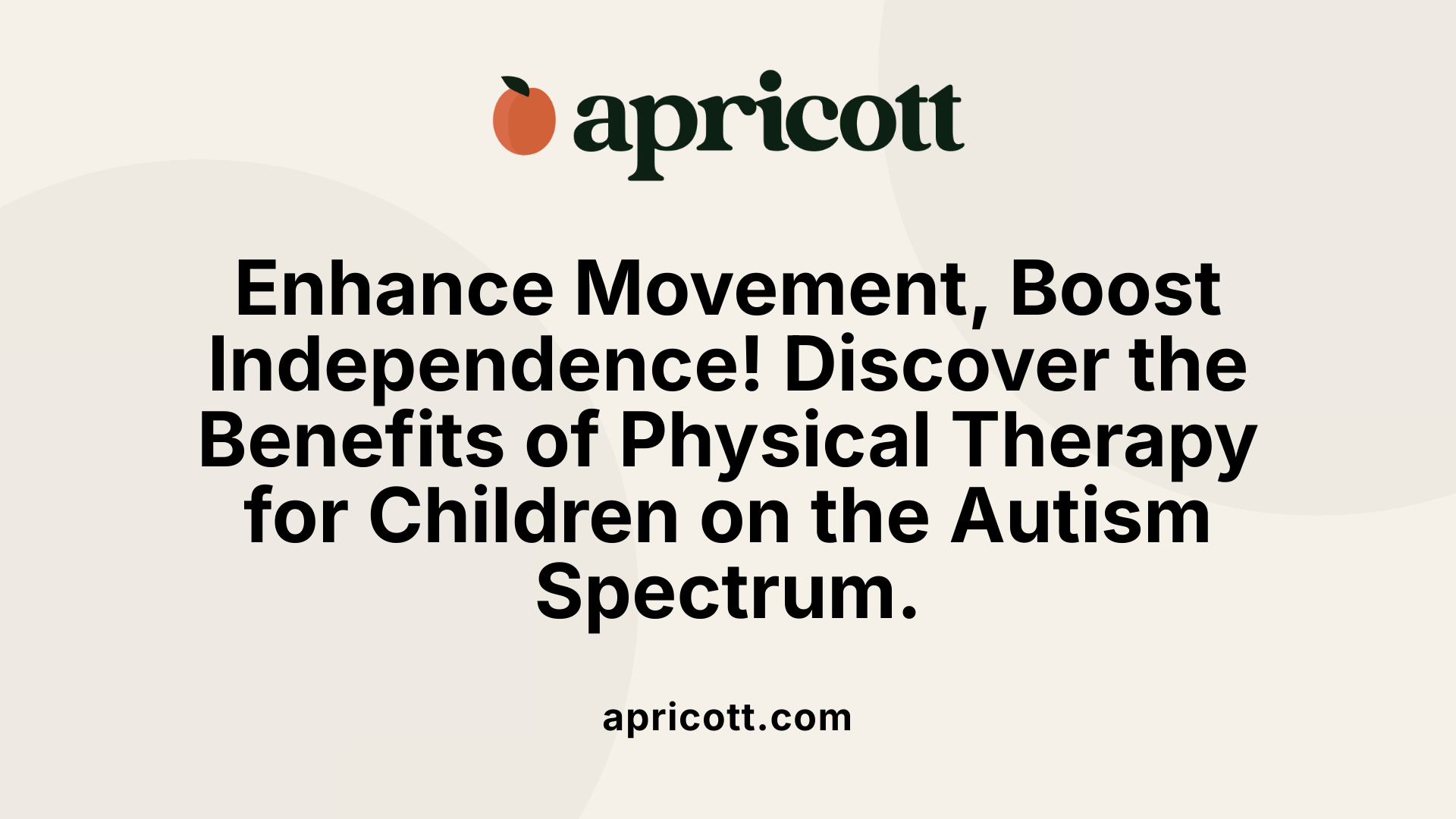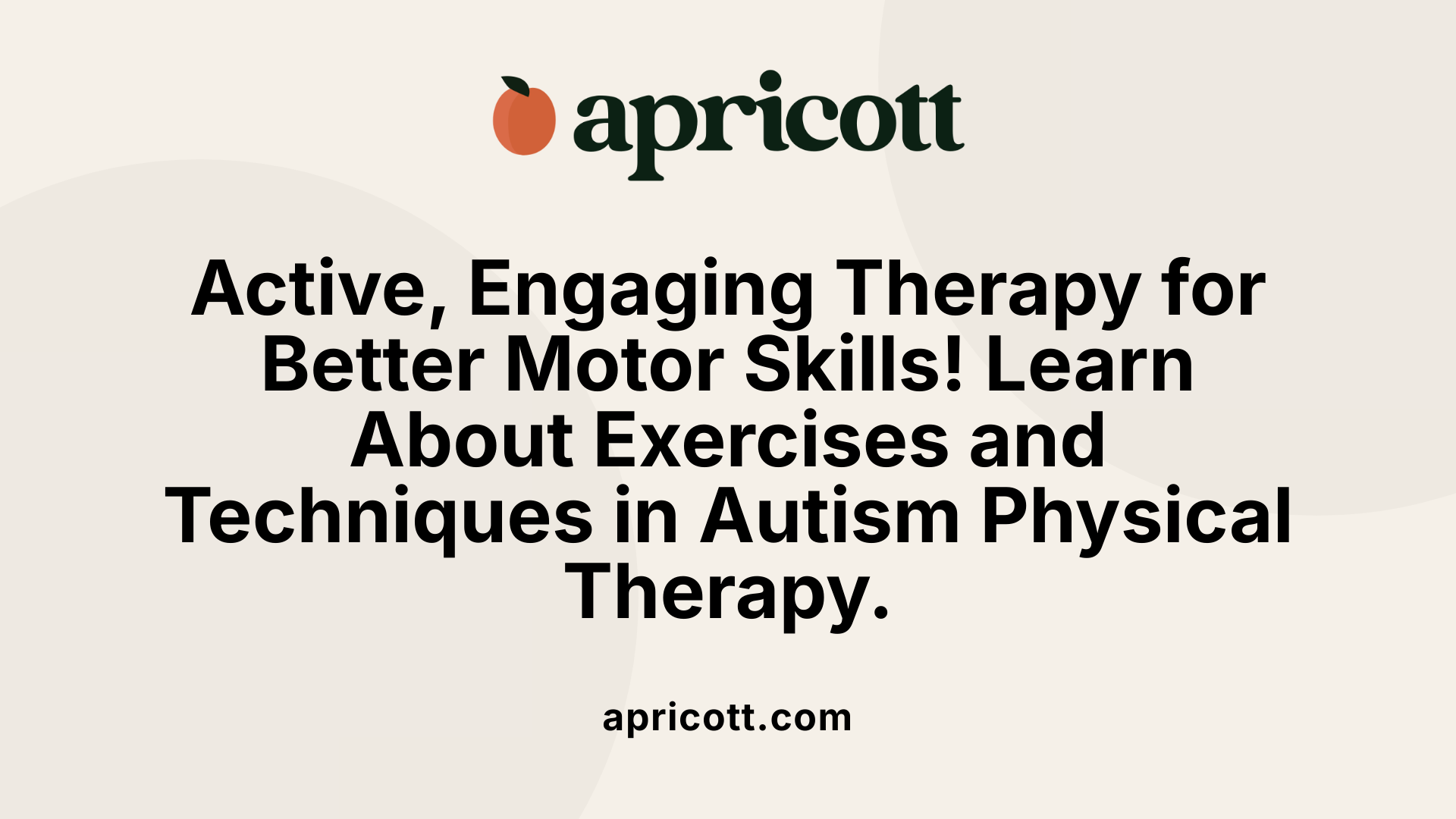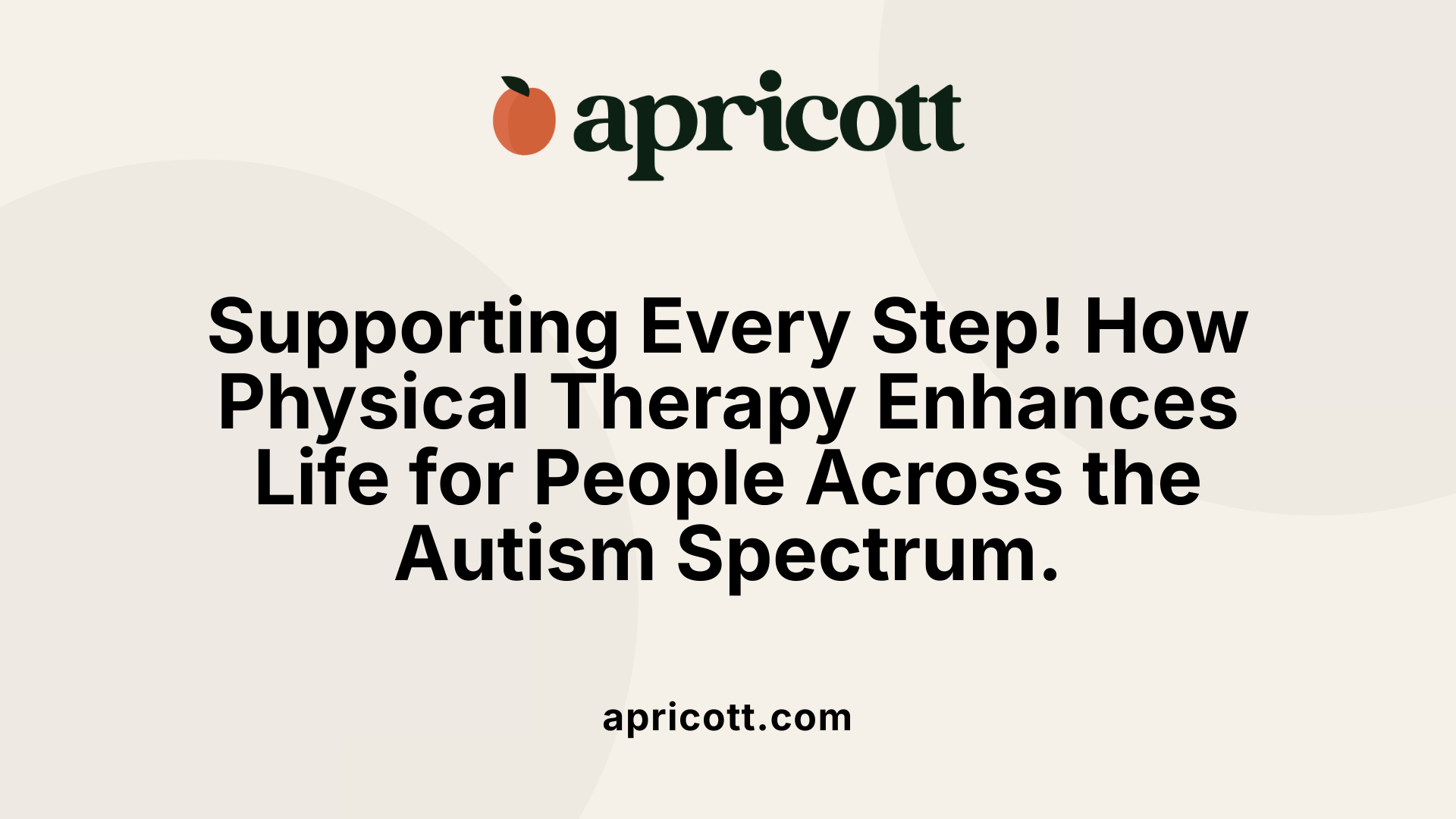Understanding the Role of Physical Therapy in Autism Support
Physical therapy is an essential intervention for children with autism spectrum disorder (ASD), focusing on improving motor skills, strength, coordination, and balance. Through targeted exercises and play-based activities, physical therapists help enhance children's participation in daily routines, social interactions, and recreational activities. This article explores the benefits, methods, research, and broader impact of physical therapy for individuals with autism.
Benefits of Physical Therapy for Children with Autism

What are the benefits of physical therapy for children with autism?
Physical therapy can bring significant improvements to children on the autism spectrum. Many children with ASD experience challenges with coordination, balance, muscle tone, and overall movement. Physical therapy helps address these issues by focusing on strengthening muscles, enhancing balance, and improving coordination skills. This not only makes daily activities such as dressing, walking, or jumping easier but also encourages active participation in play and social interactions.
Developing gross motor skills is vital for children’s independence and confidence. Through targeted exercises and activities, children can improve their ability to sit, stand, walk, run, and engage in play routines. These motor improvements often lead to increased socialization, as children become more comfortable and confident interacting with peers.
Physical therapy also supports emotional health. Engaging in fun, movement-based routines can boost mood, reduce stress, and help manage behavioral issues. It encourages physical activity, which is beneficial for overall health, and can lead to better sleep and mood regulation.
Additionally, early and consistent therapy provides a foundation for long-term improvements in physical and mental well-being. The goal is to help children achieve greater independence, participate fully in their environment, and improve their quality of life through better movement and functional skills.
Roles and Interventions Provided by Physical Therapists

What roles and interventions do physical therapists provide for children with autism?
Physical therapists (PTs) play a crucial part in supporting children with autism spectrum disorder (ASD). Their primary role is to assess each child's specific motor development needs and create personalized treatment plans. These plans aim to improve fundamental movement skills, coordination, balance, and muscle strength.
PTs utilize a variety of techniques and activities to promote motor skill development. They include exercises, play-based activities, and sensory integration therapies designed to boost gross motor functions such as jumping, throwing, catching, and balance. For example, they might incorporate fun activities like ball games, obstacle courses, or aquatic therapy, including hydrotherapy, which uses water's soothing pressure and temperature to aid mobility.
Interventions extend beyond exercises to include environmental adaptations—such as modified playground equipment or supportive seating—to facilitate participation in daily routines, school activities, and recreational pursuits. These modifications help children navigate their environment more independently and comfortably.
Early intervention focuses on addressing motor delays at a young age, improving muscle tone, coordination, and imitation skills. Ongoing therapy supports children as they grow, aiming to foster independence, social engagement, and participation in community activities.
Therapists also work within multidisciplinary teams, collaborating with occupational therapists, speech therapists, and educators. This team approach ensures that physical, sensory, and communication needs are comprehensively supported.
In summary, physical therapists serve as vital facilitators in enhancing physical capabilities and promoting overall well-being for children with ASD. Their work not only helps improve movement but also supports emotional and social growth, enabling children to connect better with their surroundings and community.
Treatment Methods and Exercises in Physical Therapy for Autism

What treatment methods and exercises are used in physical therapy for children with autism?
Physical therapy for children with autism employs a variety of techniques designed to enhance their physical capabilities and overall well-being. Physical therapists focus on implementing exercises that improve strength, coordination, balance, and mobility. These include activities like balance training, movement-based exercises, and postural control activities. Therapists develop personalized strategies tailored to each child's unique needs, helping to address delays in motor skills and promote active participation in daily routines.
Often, interventions integrate engaging activities such as jumping, crawling, throwing, hopping, and adaptive exercises. These play-based approaches make therapy enjoyable and motivating for children, encouraging consistent participation. Early therapy development concentrates on foundational skills suitable for young children, while programs for older children may incorporate movement breaks, sports, or use of adaptive equipment to support social participation.
Approaches like movement-based activities, sensory integration, hydrotherapy, and play therapy
Different approaches expand the scope of physical therapy for autism. Movement activities—like stretching, jumping, and coordination drills—target gross motor skills. Sensory integration techniques help children manage sensory sensitivities and improve their responses to input, which can reduce hyperactivity and increase focus.
Hydrotherapy, or aquatic therapy, is also used, leveraging water’s soothing properties to facilitate motor development, improve mobility, and provide calming sensory input. Play therapy remains central, utilizing toys, games, and creative activities to motivate children and reinforce functional movements in engaging ways.
Tailoring programs to individual needs and developmental stages
Each child's therapy program is customized to fit their developmental stage and specific motor challenges. For toddlers showing early delays, therapy emphasizes imitation, strength-building, and basic motor skills to foster progress across all areas of development. Older children may focus on motor planning, social play, and adaptive skills to support independence and peer interaction.
Therapists collaborate closely with families and educational teams to ensure interventions are relevant and achievable. The frequency and intensity of sessions are adjusted based on progress, with an emphasis on consistency and encouraging activity at home and in community settings.
Use of engaging activities such as jumping, crawling, throwing, and adaptive exercises
Integral to therapy are activities that promote functional movements through playful and adaptive exercises. Jumping, crawling, and throwing games develop core strength, coordination, and motor planning skills. These activities are often incorporated into daily routines to build muscle control and facilitate social interaction.
Implementation may include the use of tools like medicine balls, obstacle courses, or resistance bands to intensify mobility exercises. The goal is to nurture a variety of gross motor skills, which are associated with improved social skills, mood, and behavior.
| Therapy Focus | Activities & Exercises | Benefits |
|---|---|---|
| Strength and muscle control | Jumping, hopping, resistance drills | Increased muscle tone, better mobility |
| Balance and coordination | Balance beams, star jumps, crawl | Improved stability, safer movement in daily life |
| Sensory integration | Water-based play, tactile tasks | Better sensory responses, reduced hyperactivity |
| Functional mobility | Throwing, catching, adaptive play | Enhanced independence and social participation |
Research Findings and Evidence-Based Approach to Physical Therapy
 Current research suggests that physical therapy can play a valuable role in supporting children with autism spectrum disorder (ASD). It has been shown to enhance motor skills, balance, and coordination, which are often areas of difficulty for children on the spectrum.
Current research suggests that physical therapy can play a valuable role in supporting children with autism spectrum disorder (ASD). It has been shown to enhance motor skills, balance, and coordination, which are often areas of difficulty for children on the spectrum.
Systematic reviews and meta-analyses, including a notable review of 28 randomized controlled trials (RCTs) with over 1,000 participants, reveal promising results. These studies indicate that physical exercise therapy (PET) may improve core autism symptoms such as motor performance, social dysfunction, and restricted repetitive behaviors. The data suggests that longer and more frequent therapy sessions could lead to even better outcomes, helping reduce ASD severity.
While the evidence points toward positive effects, many existing studies face limitations. Most trials have a high risk of bias and varying levels of methodological quality. This means while results are encouraging, further high-quality research is necessary to firmly establish the effectiveness of physical therapy for ASD.
Practically, therapies are often tailored to each child's needs, using engaging activities like play, balance exercises, and aquatic therapy. Sessions can take place in various settings, including home and school, involving play-based motivation. Overall, balancing the current evidence, physical therapy remains a promising complementary approach to help improve motor skills and potentially lessen some behavioral symptoms of autism.
Broader Impact and Support Across the Autism Spectrum

How can physical therapy support individuals across the autism spectrum?
Physical therapy (PT) plays a vital role in helping people with autism spectrum disorder (ASD) improve their movement and physical abilities. Many children and adults with ASD face challenges in coordination, balance, and strength, which can affect their daily lives and social interactions.
PT focuses on developing gross motor skills such as jumping, running, and balancing, all of which are essential for participating in play, school activities, and community life. Therapists use fun, engaging exercises like swimming, dance, and play-based activities to motivate and encourage movement, helping individuals achieve physical milestones.
The support extends beyond childhood, assisting older individuals in maintaining mobility and independence. This ongoing development fosters confidence, enhances self-esteem, and contributes to overall well-being.
A multidisciplinary approach often includes sensory integration techniques that help manage sensory processing issues common in ASD. These techniques aid in reducing hyperactivity, stress, and behavioral difficulties, promoting calmness and emotional regulation.
Physical therapy not only addresses physical challenges but also supports emotional health by encouraging positive interactions and self-expression through movement. This holistic approach helps improve social participation, foster better communication, and promote a healthier lifestyle.
Ultimately, tailored PT programs aim to improve quality of life across all ages, empowering individuals on the spectrum to engage more fully in their environments and achieve greater independence.
Fostering Development and Independence in Children with ASD
Physical therapy is a valuable component of comprehensive care for children with autism. It not only addresses physical challenges such as poor coordination, low muscle tone, and balance issues but also indirectly supports social skills and emotional regulation. With ongoing research emphasizing its benefits and tailored approaches, physical therapy enhances children's ability to participate actively in all aspects of life. Early intervention and collaborative efforts among therapists, families, and educators are essential to maximize its positive impact, ultimately fostering greater independence, well-being, and improved quality of life for individuals across the autism spectrum.
References
- Physical Therapy Guide to Autism Spectrum Disorder
- Physical Therapy for Autism | NICHD
- The Role of the Pediatric Physical Therapist for Childen ...
- The Top 5 Benefits of Physical Therapy for Children with ...
- Autism Spectrum Disorder and Motor Development
- The effect of physical exercise therapy on autism spectrum ...
- The effect of physical exercise therapy on autism spectrum ...
.svg)
.svg)








